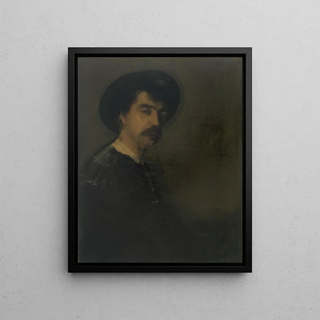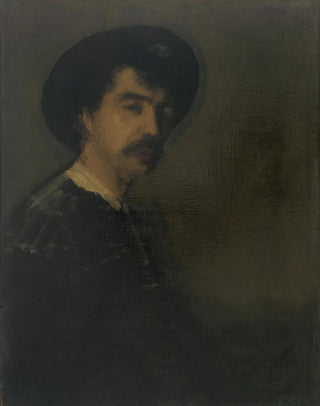Art print | Self-portrait - James Abbott McNeill Whistler


View from behind

Frame (optional)
James Abbott McNeill Whistler's Self-Portrait is an iconic artwork that transcends the simple exercise of personal representation. This painting, both introspective and bold, immerses us in the complex universe of the artist, revealing his thoughts, emotions, and relationship with the world. Whistler, a prominent figure of the Impressionist movement, uses this canvas to express himself, but also to question the observer's view on art and beauty. This masterpiece, both intimate and universal, invites deep reflection on identity and subjectivity, essential elements of the human experience.
Style and uniqueness of the work
Whistler's style is often characterized by an innovative approach to color and light, and this art print is no exception. The color palette chosen by the artist is subtle, oscillating between dark tones and luminous flashes that give the work an almost ethereal atmosphere. The way he plays with shadows and lights reveals his desire to capture not only physical appearance but also the very essence of his being. The brushstrokes, both delicate and assertive, demonstrate his technical mastery and artistic sensitivity. Whistler does not seek to conform to the standards of his time but rather to create a dialogue between the subject and the viewer, making this art print a unique piece in the 19th-century artistic landscape.
The artist and his influence
James Abbott McNeill Whistler, born in 1834, is an emblematic figure of modern art. His influence extends far beyond his personal production, impacting many artists who followed. Whistler was a pioneer in the use of color and composition, prefiguring movements such as Fauvism and abstraction. His approach to portraiture, often tinged with a quest for personal truth, paved the way for a new understanding of the art print as a means of expression. By depicting himself, Whistler not only reveals his image but also explores themes of perception and illusion, concepts that still resonate today in the

Matte finish

View from behind

Frame (optional)
James Abbott McNeill Whistler's Self-Portrait is an iconic artwork that transcends the simple exercise of personal representation. This painting, both introspective and bold, immerses us in the complex universe of the artist, revealing his thoughts, emotions, and relationship with the world. Whistler, a prominent figure of the Impressionist movement, uses this canvas to express himself, but also to question the observer's view on art and beauty. This masterpiece, both intimate and universal, invites deep reflection on identity and subjectivity, essential elements of the human experience.
Style and uniqueness of the work
Whistler's style is often characterized by an innovative approach to color and light, and this art print is no exception. The color palette chosen by the artist is subtle, oscillating between dark tones and luminous flashes that give the work an almost ethereal atmosphere. The way he plays with shadows and lights reveals his desire to capture not only physical appearance but also the very essence of his being. The brushstrokes, both delicate and assertive, demonstrate his technical mastery and artistic sensitivity. Whistler does not seek to conform to the standards of his time but rather to create a dialogue between the subject and the viewer, making this art print a unique piece in the 19th-century artistic landscape.
The artist and his influence
James Abbott McNeill Whistler, born in 1834, is an emblematic figure of modern art. His influence extends far beyond his personal production, impacting many artists who followed. Whistler was a pioneer in the use of color and composition, prefiguring movements such as Fauvism and abstraction. His approach to portraiture, often tinged with a quest for personal truth, paved the way for a new understanding of the art print as a means of expression. By depicting himself, Whistler not only reveals his image but also explores themes of perception and illusion, concepts that still resonate today in the






